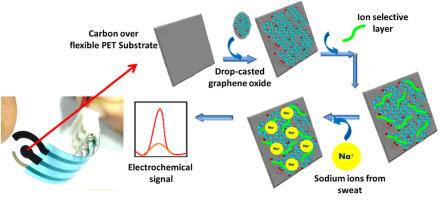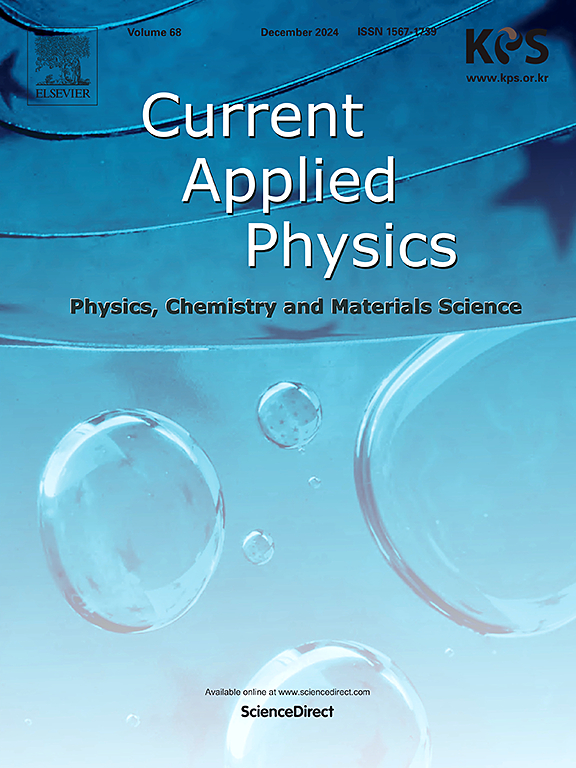Flexible screen-printed graphene oxide-based biosensor for sweat sodium detection
IF 3.1
4区 物理与天体物理
Q3 MATERIALS SCIENCE, MULTIDISCIPLINARY
引用次数: 0
Abstract
Sweat contains valuable biomarkers indicative of physiological health conditions such as electrolyte imbalance, stress, and disease, enabling continuous, non-invasive monitoring through miniaturized wearable electrochemical biosensors. Here, a flexible, cost-effective electrochemical sweat Na+ ion sensor is fabricated using a screen-printing method on a flexible polyethylene terephthalate (PET) substrate. The sensor incorporates a low-cost Ion-Selective Layer (ISL) and graphene oxide (GO) enhancing sensitivity and electrochemical performance across a broad range of Na+ ions. The sensor exhibits a high sensitivity of 1.213 mA/mM.cm2, low limit detection of 14.49 mM, and good stability. Real-time sweat analysis demonstrated Na+ ion levels of 19 mM in the morning and 23 mM in the evening aligning with the analytical range of Na+ ion concentration in sweat. This work addresses challenges in precision and individual variability in Na+ ion concentration highlighting the potential of scalable, affordable sensors in wearables technology for personalized health monitoring.

用于汗液钠检测的柔性丝网印刷氧化石墨烯生物传感器
汗液包含有价值的生物标志物,表明生理健康状况,如电解质失衡、压力和疾病,可以通过微型可穿戴电化学生物传感器进行连续、无创监测。在这里,使用丝网印刷方法在柔性聚对苯二甲酸乙二醇酯(PET)衬底上制造了一种柔性的,具有成本效益的电化学汗液Na+离子传感器。该传感器结合了低成本的离子选择层(ISL)和氧化石墨烯(GO),提高了在广泛的Na+离子范围内的灵敏度和电化学性能。该传感器具有1.213 mA/mM的高灵敏度。cm2,下限检出14.49 mM,稳定性好。实时汗液分析显示,上午19 mM和晚上23 mM的Na+离子水平与汗液中Na+离子浓度的分析范围一致。这项工作解决了Na+离子浓度在精度和个体可变性方面的挑战,突出了可穿戴技术中可扩展、价格合理的传感器在个性化健康监测方面的潜力。
本文章由计算机程序翻译,如有差异,请以英文原文为准。
求助全文
约1分钟内获得全文
求助全文
来源期刊

Current Applied Physics
物理-材料科学:综合
CiteScore
4.80
自引率
0.00%
发文量
213
审稿时长
33 days
期刊介绍:
Current Applied Physics (Curr. Appl. Phys.) is a monthly published international journal covering all the fields of applied science investigating the physics of the advanced materials for future applications.
Other areas covered: Experimental and theoretical aspects of advanced materials and devices dealing with synthesis or structural chemistry, physical and electronic properties, photonics, engineering applications, and uniquely pertinent measurement or analytical techniques.
Current Applied Physics, published since 2001, covers physics, chemistry and materials science, including bio-materials, with their engineering aspects. It is a truly interdisciplinary journal opening a forum for scientists of all related fields, a unique point of the journal discriminating it from other worldwide and/or Pacific Rim applied physics journals.
Regular research papers, letters and review articles with contents meeting the scope of the journal will be considered for publication after peer review.
The Journal is owned by the Korean Physical Society.
 求助内容:
求助内容: 应助结果提醒方式:
应助结果提醒方式:


